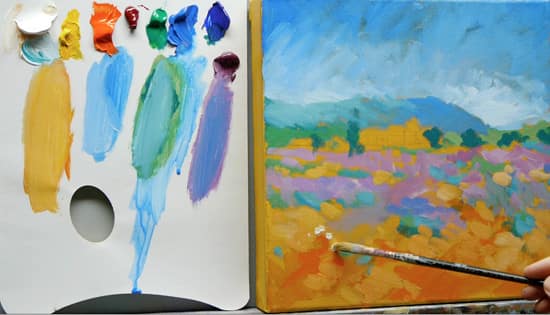
A step-by-step Impressionist Acrylic Painting – Part 2
In this painterly, impressionistic landscape series, I am posting a weekly video on my YouTube channel so that you can follow along at home.
It’s free to subscribe to the blog to receive updates so you can keep up with the painting progress…
How to paint like Monet – Free video Course |Part 2
This video below shows the next steps I take to build up this impressionistic landscape painting.
The next 6 steps
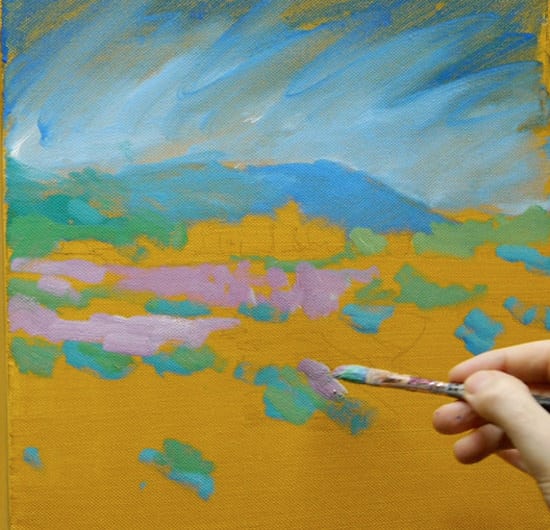
Step 1. Introducing Lilac
I mix a lilac using Cobalt Violet Hue and Titanium White. We are just blocking in the colours using short marks that leave some of the Yellow Ochre underpainting shining through, to get a feel for the colour harmony of the piece.
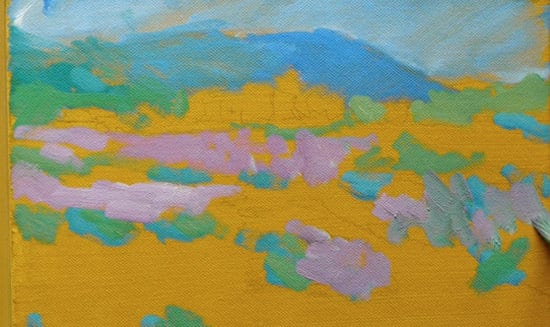
The double-loaded brush
If you notice, on my brush, each side has a different colour. I had dipped one side into the green mix and then twiddled the brush in my fingers to load up with some of the purple colours.
I can then paint a more broken colour effect very easily without going back to the palette. This produces a lovely muted tone with the acrylics, often more associated with Oils, as the colours mix in together ‘wet into wet’.
Pro tip: This technique can be very useful when depicting waves on a seascape when using a flat brush. Load up one edge with a white and the other edge with whichever blue you are painting with. You can then create a mixture of colours just using one stroke of the brush.
Step 2. Adjusting the sky
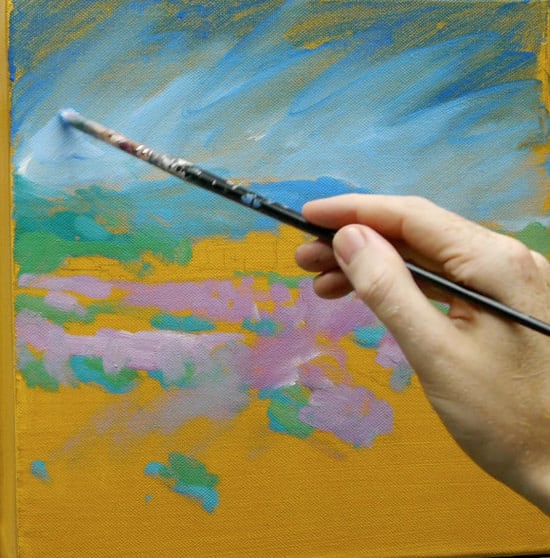
Now we have some of the foreground lilacs in the painting, it’s easier for me to judge how light or dark to go in the sky, so I can start to work with thicker paint to add some movement.
Don’t forget the reference photo is just a guide, don’t get too hung up if the shapes aren’t exactly right.
Check your corners
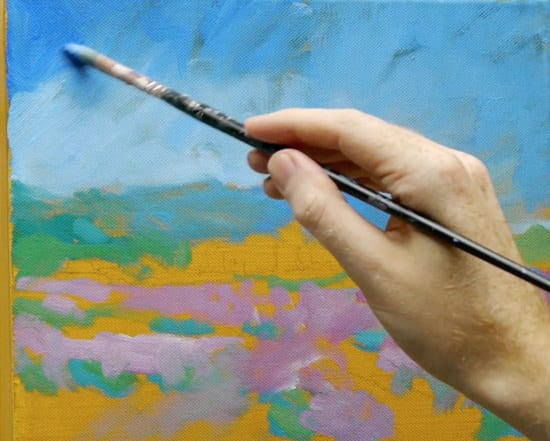
In landscape painting, the corners are very important. I often darken the corners to help bring the viewers eye back into the piece, particularly when the sky is very simple.
In this lesson, it helps to draw focus to the building in the middle of the painting.
In the next step, we can start to introduce darker tones to enhance the focal point.
Step 3. Mixing the darker green
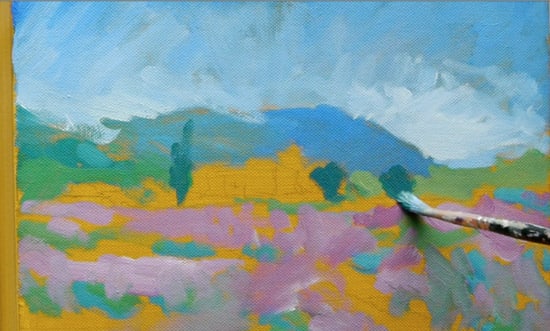
Using a mix of the Permanent Green Light and the Ultramarine Blue (the darker of the two blues we’re using) I can create a mix similar to Viridian Monet used on his palette. Another alternative green is Phthalo Green which is very close in tone to Viridian.
Notice how the dark green shapes surround the building; this contrast will help later on in the painting.
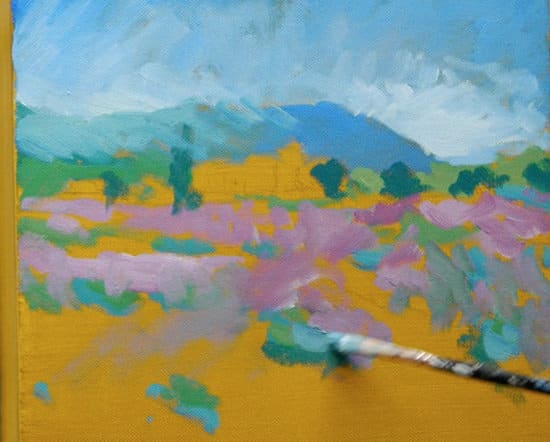
I then start to apply thicker paint than before and correct some of the drawing on the mountain.
I mix a turquoise using the Permanent Green Light and the Cobalt Blue.
When this colour is mixed, I scan the reference image for any examples of this colour appearing in the piece’s foreground. This helps to unify the painting and give a movement of colours throughout the painting. I use short strokes to apply the paint slightly more impasto (thicker) than the initial wash in. These dabs of colour help move the viewer’s eye around the painting; I add white to the mixture to vary the tints slightly.
Step 4. Introducing warm colours into the foreground
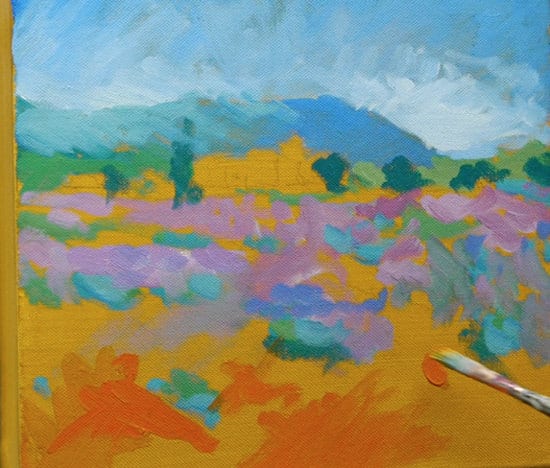
Using a watery mix of the Cadmium Red Light and the Cadmium Yellow Medium, I mix an orange that I can block in to create a strongly coloured undertone for the lighter, more impasto brush marks that come next.
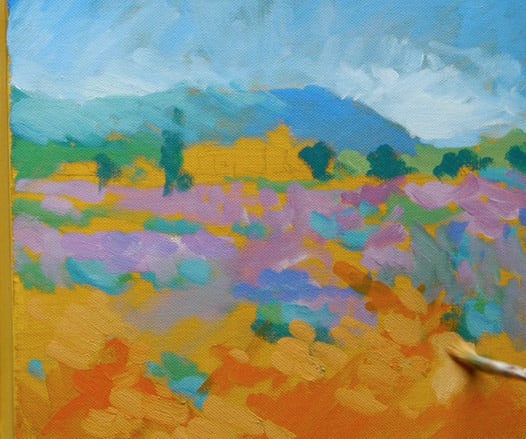
I then use the same optical mixing principle using broken colours, by dabbing thicker, lighter, yellower paint on top.
This is the same technique as when we applied a coloured ground to start the painting.
The great thing about acrylics is you can apply theses little areas of intense colour to other parts of your paintings to add interest and contrast. You can see how Van Gogh used a similar technique here.
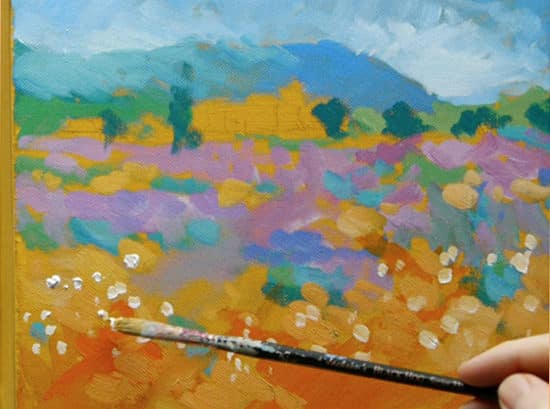
Using quite a thick paint on my brush, I then gently dab thick, white flecks of colour to give the impression of flower heads.
Step 5. Blocking in the building
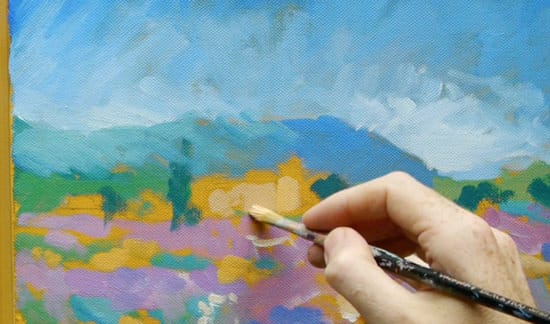
I mix a cream using the white, yellow and a touch of the Cadmium Red Light for the side of the building being hit by the sunshine.
For the shadow side of the building, I simply mix in a touch of the Cobalt Violet.
As purple is the complementary colour of yellow it helps to darken it down and produce a shadow that still has colour in it.
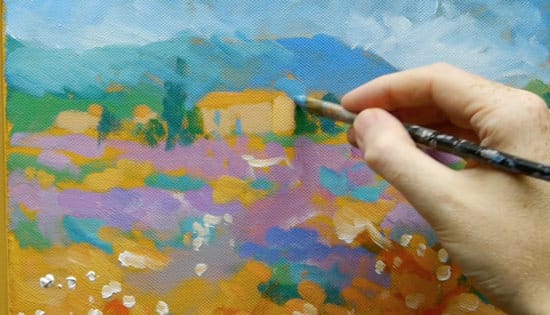
I then refine the building’s edges and add detail using a mix of Cobalt Blue and white.
Step 6.
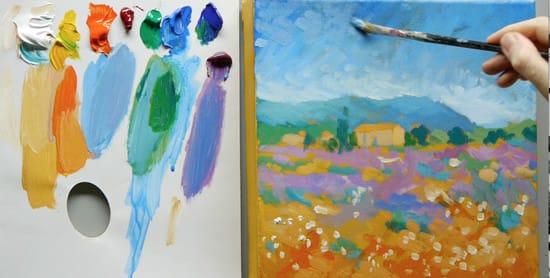
To finish off the sky, I mix in a bit of the Cobalt Violet to create a more muted blue, so it balances with the rest of the painting.
I also vary the direction of the brushstrokes to add interest.
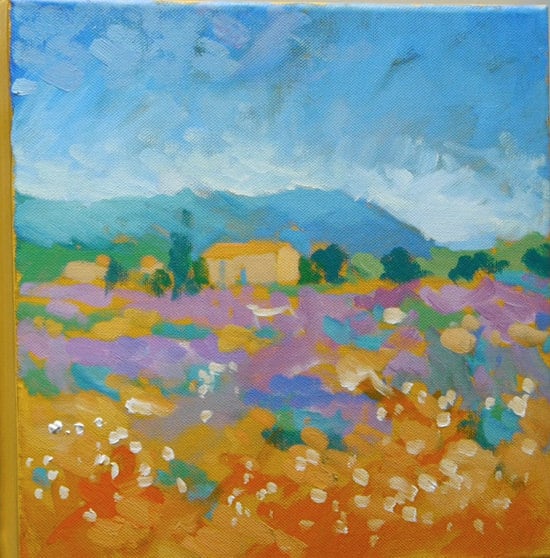
The impressionist painting at the end of Part 2.
Make sure to subscribe (it’s free) to keep updated; you’ll get email updates when the next video is posted.
Next week, for Part 3, we’ll start to add more details and complementary colours to bring it to more a finish.
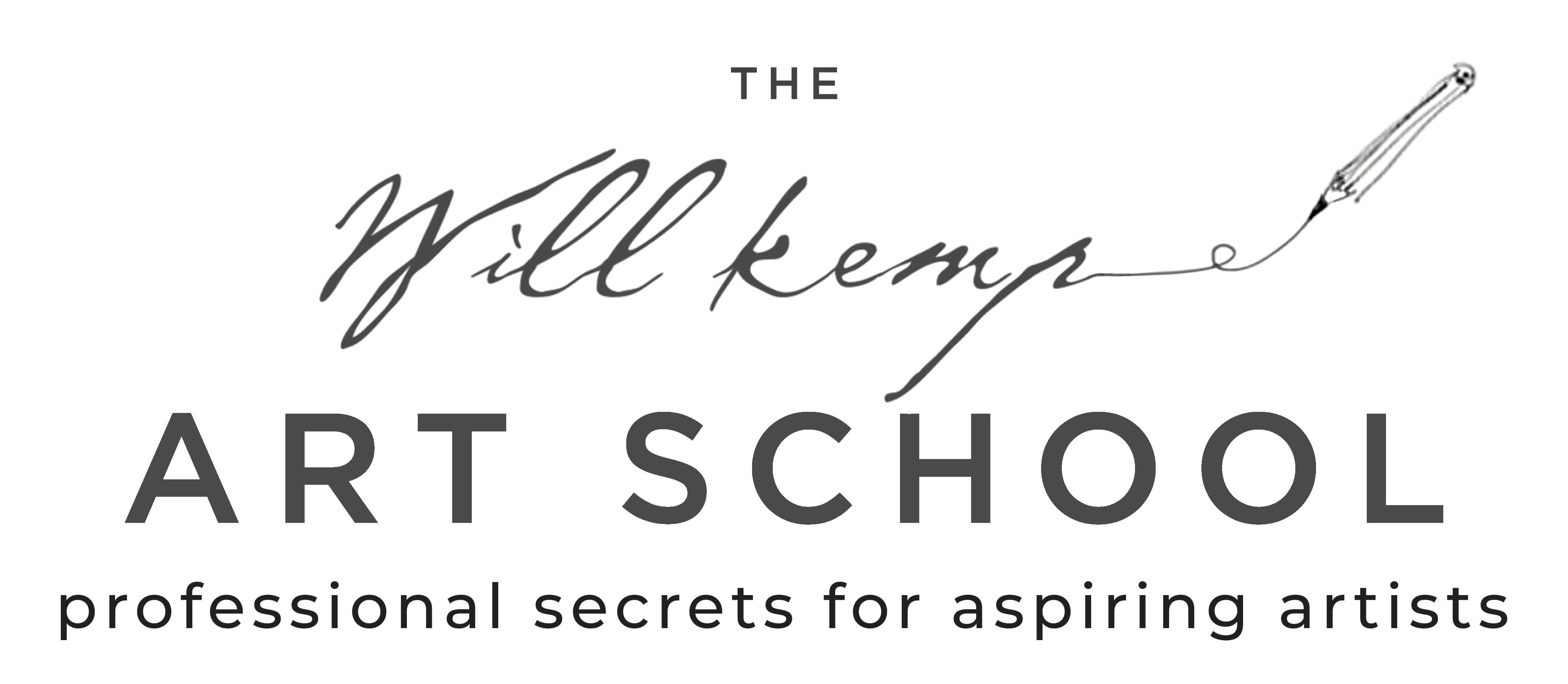
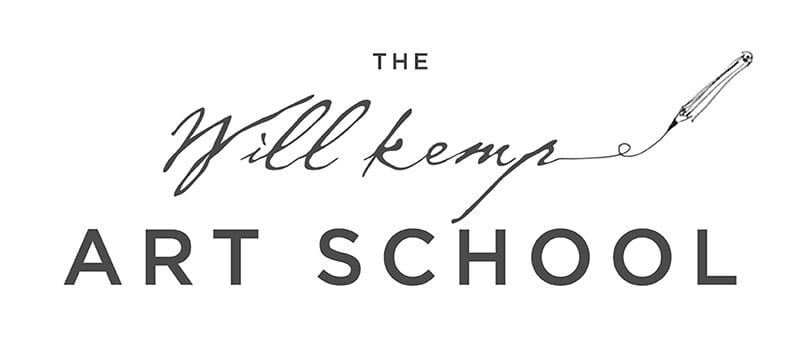
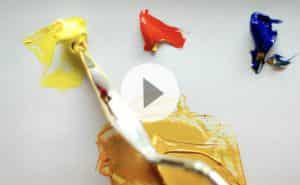
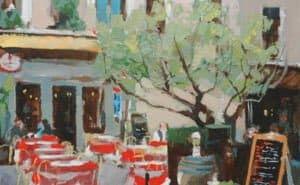
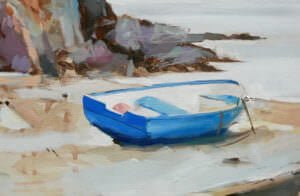
Will, thank you for sharing your awesome talent in such an easy to follow format! You have taken all the fear out of learning to paint!
Hi Jeanie,
You’re welcome, so pleased the tutorials are helping to take the fear factor out of painting. Taking things one step at a time can really produce some fantastic results.
Thanks,
Will
Dear William,
I deeply appreciate you lessons, very helpful, free, the best training courses and techniques. I am using all of your guidelines, which have not been able to find, anywhere else.
By the way, would you please tell us what kind of canvases are you using? the texture is very nice helping the shades look three dimensional?
My best wishes
ardeshir
Hi Ardeshir,
Thanks for your kind words on the painting tutorials.
The canvas I’m using is a pre-primed Winsor & newton 12 x 12 inch deep edge canvas.
Lesson 1 has a full art material list,
Thanks,
Will
Great advice. I really appreciate how you break it down into small pieces. Thank you
Cheers Tom, great to hear it’s easy to understand.
Will
Brilliant.
I’m a professional artist of 30+ years and I can still learn a lot from other artists, but I find your videos especially inspiring. I also love your peaceful tone of voice. Thanks for not skipping any steps and letting us watch the whole process. Paint on!
Thanks very much Elizabeth, much appreciated, really pleased you enjoyed the painting.
Will
So much fun! Thank you so much!
Thanks Elizabeth, pleased ou enjoyed it.
Will
hey Will,
I’m an sculptor and I’ve recently started painting too, since I’ve always loved to.
this is really lovely to see how you break into steps and make it easy and simple to understand and follow.
the videos are so motivating as you yourself are, I’m sure.
I had a drawing professor once that always used to say: “you have to draw somehow that if you die in the middle, the artwork is already finished.”
you are the best example of this quote in the painting. All the paintings can be considered finished in all the steps.
just wanted to thank you for being so generous and motivated at the same time.
I’d also love to see your own paintings and know your taste as an artist.
Afra
Really pleased you’ve been enjoying the lessons Afra and glad you’ve found the steps helpful.
Cheers,
Will
Cheers, Will!!
I found this on your website and was instantly carried away with your easy style and
direct simple way! Am finally able to begin to produce beginning works! After 60 years
of studying both on my own and with a university I finally see the light!! I cannot
thank you enough – and my husband who bought me a set of acrylics and an easel
last Christmas! Long Live Monet!!
Brightly
Karen Hulen
Really pleased you enjoyed it Karen! great that you’ve been finding the lessons helpful in creating new works.
Cheers,
Will